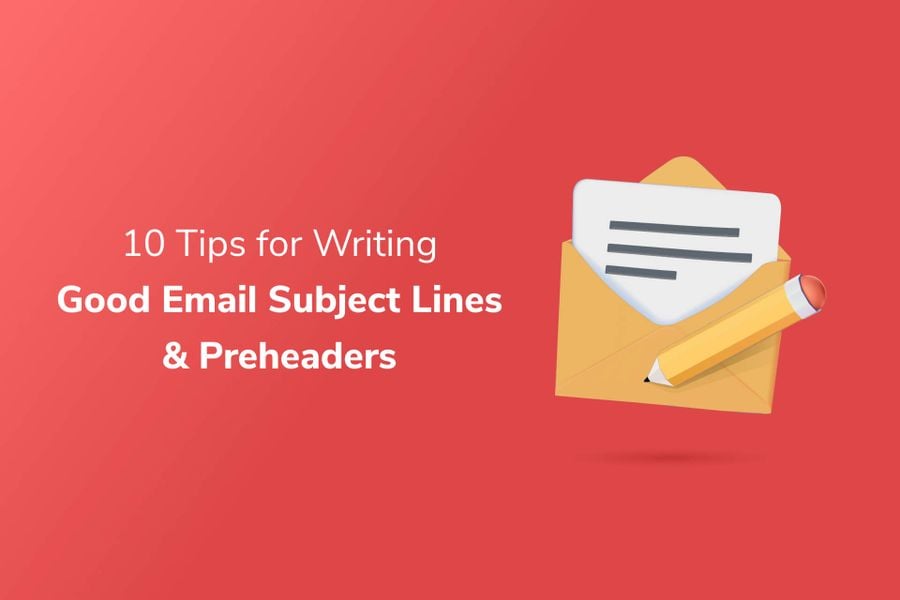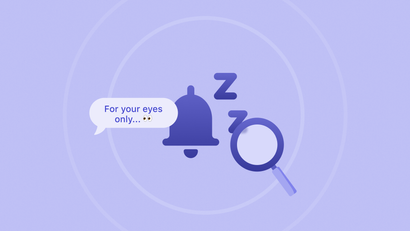What is an Email Subject Line?
Your email subject line is the first line of text a recipient sees when your emails land in their inbox. Among the hundreds of emails cluttering a recipient’s inbox, your subject line needs to stand out to capture a reader’s attention enough to prompt them to open and read your content.
Your email subject line may be small piece of copy, but it’s also the gateway to clicks, opens, and engagement. It’s important to put thought into your subject line copy so that the effort and value you put into the email itself isn’t wasted.
What is an Email Preheader?
Right after your email subject line comes your email preheader text. This copy is typically the length of a single sentence. Preheader text isn’t a required email field, but it should still be a focus in your email marketing efforts, as it gives you an additional opportunity to communicate the value of what’s inside.
Your email subject line and preheader go hand in hand and can make or break your email results.
It’s important to note that different email clients display preheader text differently. Each provider has different preheader text limits, and the amount of preheader text displayed on mobile devices varies. Generally, your preheader text should be between 40 and 130 characters long to optimize for different devices.
What’s the Difference Between the Two?
If you’re new to using email, you might be wondering about the difference is between an email header and an email subject line. Email headers trace the origin of an email and contain a lot of juicy information, such as the email sender, recipient, and tracking information. Your subject line is included in your email header and is used alongside other metadata for security and authentication purposes.
Advice for Subject Lines and Preheaders
1) Stay Concise
To make sure your email subject lines don’t get cut off when recipients view your content in their inboxes, you’ll want to keep your copy short. Generally, it’s best to keep your subject lines under 50 characters in length to avoid your message getting truncated. To abbreviate subject lines that are too long, think about ways to reword your message or eliminate unnecessary words.
2) Emphasize Scarcity
The less of something there is, the more consumers want it! Scarcity is a fundamental principle of influence in Robert Cialdini’s famous work The Power of Influence and is used by marketers and advertisers everywhere.
Creating a sense of scarcity in your email subject lines and preheaders can motivate your audience to take action more quickly.
“Your last chance to buy at half price”
If you want to be even more effective in your scarcity messaging, you should also consider the difference between a “gain frame,” which emphasizes the net benefits of the offer and a “loss frame,” which emphasizes the consequences of not acting on the offer.
3) Keep Your Recipients Curious
A classic copywriting tip is to pique a reader’s interest with a subject line that’s mysterious or suspenseful. Sometimes being intentionally vague is the best way to capture a reader’s attention. It’s like receiving a “We need to talk” or “I have to tell you something” text. The suspense is too much to handle, and the recipient of the message can’t help but wonder about the content of the following conversation, or in this case, email body.
An easy way to inspire curiosity is by framing your subject with intrigue. Your health and lifestyle company might use the subject line “The secret to a successful sleep routine” in an email promoting new content on your website. If you’re in financial services, you might use a subject line like “This is how I became a better investor” to tease recipients to open.
4) Include Personalization
There are a variety of ways to personalize your subject lines. 91 percent of consumers say they are more likely to shop with brands that serve up personalized, relevant content than those that don’t.
You can personalize your subject lines with data such as a recipient’s first name, transaction history, or location. The details you’ll be able to use in personalizing your subject lines will depend on what data you collect on your customers.
First name personalization can be powerful in that it makes a recipient feel like an individual human being, rather than a number on your contact list. Studies by various email providers show that using a first name in a message significantly increases open rates. “Carla, here's a special offer just for you.”
Don't know where to start with email personalization? Our guide to email optimization keeps all campaign-boosting strategies in the one convenient place.
5) Use a Numbered List
There’s a reason that listicals are a popular way of framing content across channels and industries. You’re reading this post for a reason, right?
Humans have an affinity for numbered lists, because our brains have a simpler time digesting information that’s clearly differentiated. Lists reduce the amount of conscious effort we have to exert to perform the task of reading, which is why we intuitively gravitate towards information presented to us in this way.
That said, you should try using numbered lists as a tactic in your email subject lines. As a health app your email subject line could read “10 foods to increase your energy.”
6) Offer a Solution
Emphasizing that the body of your email contains the answer to your recipients’ questions or can meet their needs is an excellent way to entice them into clicking.
Use your subject lines and preheaders to convey value related to what you provide, whether it’s a good, service, software, or company resource related to your core business.
Think about why your clients are with you and how you can best serve their needs. Humans are lazy and we’re always looking for quick fixes. That’s why subject lines like “The Simplest Way to..” or “This is how you can..” are excellent ways to reengage users.
Conveying that your email content offers a direct solution upfront in your subject line and preheader is an effective way both to incentivize a click and to build trust and loyalty.
7) Avoid Spam "Trigger Words"
Email providers are just out to protect their recipients. To do so, these algorithms react to words or phrases that are typically fraudulent and risks sending these emails to the spam folder. To reduce the chances that your emails get flagged as spam for using these words, omit them from your email subject lines altogether. Not only do spam trigger words put your deliverability at risk, but they also deter your recipients from opening your content. Your recipients will likely react poorly to a subject line that sounds spammy and aggressive.
8) Use Emojis Tastefully
Emojis can be an excellent way to differentiate your emails from the flood of other communications your recipients are receiving via email. Emojis make your content more expressive and playful and spur an immediate and intuitive response. Brands that use emojis in their email subject lines see noticeably higher open rates than text-only messages.
According to Jess Nelson of Email Marketing Daily,
“The use of emojis in mobile and email marketing messages has increased by 775% year-over-year.”
Using emojis also doubles as a way to conserve space in your subject lines, which relates back to tip number one. The only caveat with emojis is they may be inappropriate for certain brands. Make sure emojis fit within your brand style constraints before including them in campaigns. For example, emojis may be fitting for a cosmetic brand’s communications, but not so much for a financial services institution.
9) Avoid the Hard Sell
Remember that the purpose of your subject line and preheader is to get readers to open your email, not to make the final sale. Using overly salesy copy in your email subject lines and preheaders can easily backfire on your strategy, because readers can interpret your content as pushy, which could lead them to delete your message or leave it unopened.
The goal of your subject line and preheader text is to inspire recipients to read your email content as part of nurturing them towards a sale. It’s not usually the best place and time to aggressively convert them. Remember that the content of your email body can frame your deals and offers as enticing, provided that your initial subject line doesn’t drive them away. At the end of your email body, you’ll have the opportunity to offer your next call-to-action (CTA).
10) A/B Test Your Subject Lines
A/B Testing —also known as bucket testing or split testing— can help you test different message variations in order to understand what types of communication resonate most with your audience. Unfortunately, there’s no one-size-fits-all formula for writing effective email subject lines and preheaders, so make sure you’re testing these different tips and iterating on your approach as you go.
Strengthening your Email Onboarding Approach
Learn how you can use email to effectively onboard your users as a mobile-first company.
Read: What to Include in a User Onboarding Email



